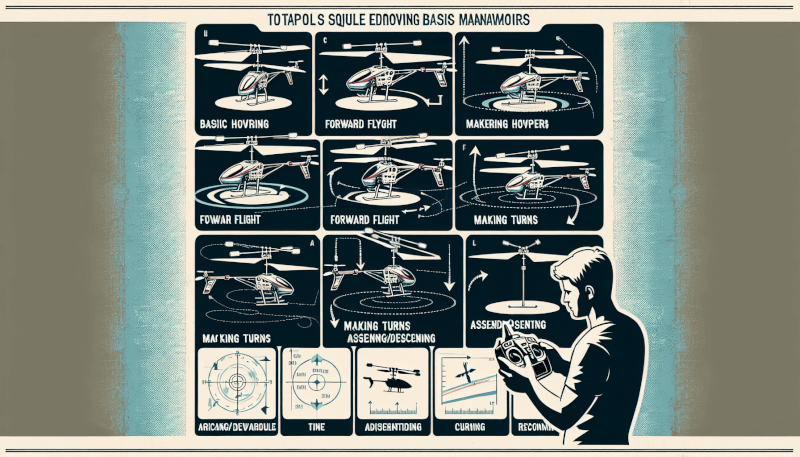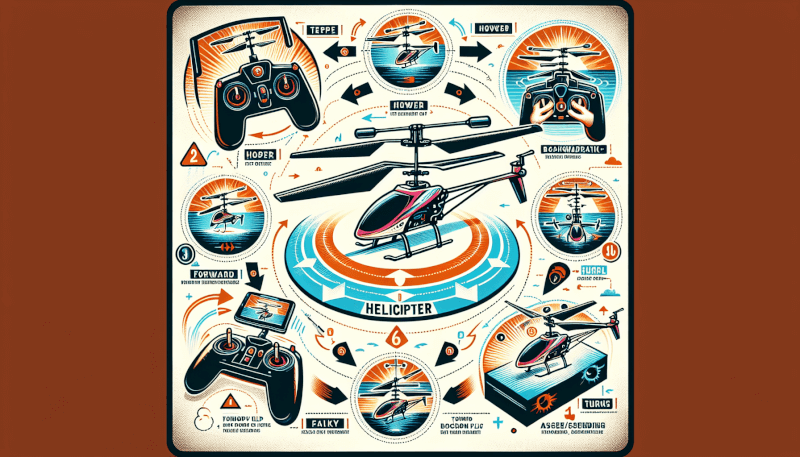Are you ready to take your love for RC helicopters to the next level? In this article, you will discover the exciting world of basic RC helicopter maneuvers. Whether you’re new to flying or looking to improve your skills, these maneuvers will allow you to perform impressive twists, turns, and flips with your RC helicopter. Get ready to soar through the skies and leave your friends in awe with your newfound flying abilities. Let’s get started!
Pre-flight Preparation
Before you start flying your RC helicopter, it is essential to perform some pre-flight checks to ensure everything is in order.
Check the helicopter’s battery
First and foremost, it is crucial to check the battery of your helicopter. Make sure it is fully charged and securely connected. You don’t want your helicopter losing power in mid-flight!
Inspect the blades and rotor system
Next, thoroughly inspect the blades and rotor system of your helicopter. Look for any signs of damage, such as cracks or dents. It is essential to have well-maintained blades to ensure a smooth and safe flight.
Ensure proper transmitter and receiver connection
Lastly, before taking off, double-check if the transmitter and receiver are correctly connected. This connection allows you to control your helicopter effectively. Make sure the connection is secure and functioning correctly to avoid any control issues during your flight.
Takeoff and Landing
Now that you have completed the pre-flight preparation, it’s time to take off and land your RC helicopter.
Power up the helicopter
To start your helicopter, turn on the power switch on your transmitter followed by the helicopter itself. This ensures a safe power-up sequence that prevents any unexpected movements.
Gradually increase throttle for takeoff
With your helicopter powered on, gently increase the throttle to lift your helicopter off the ground. Press the throttle stick up slowly and steadily, allowing your helicopter to gain altitude smoothly.
Control altitude during flight
Once your helicopter is airborne, you can control its altitude by adjusting the throttle. Push the throttle stick up to increase altitude and pull it down to decrease altitude. Maintain a steady altitude throughout your flight for stability and control.
Slowly reduce throttle for landing
When it’s time to land your helicopter, slowly reduce the throttle to bring it down gently. Gradually decrease the throttle until your helicopter touches the ground smoothly. Remember to maintain control as you land to prevent any sudden movements.

Hovering
Hovering is a fundamental maneuver for any RC helicopter pilot. Mastering hovering allows you to maintain a stable position in the air.
Maintain a steady altitude
While hovering, it is crucial to maintain a steady altitude. Use the throttle to make small adjustments and keep your helicopter at a consistent height. This skill will become particularly useful when performing more advanced maneuvers.
Use cyclic controls to maintain position
To maintain your helicopter’s position while hovering, you’ll need to use the cyclic controls. By manipulating the cyclic controls, which include the forward/backward and left/right movements, you can keep your helicopter in the desired spot.
Coordinate throttle and cyclic controls
During hovering, it is essential to coordinate the throttle and cyclic controls smoothly. This coordination helps you maintain stability and control over your helicopter. Experiment with combining these controls to achieve the desired hovering position.
Forward Flight
Once you have mastered hovering, it’s time to move on to forward flight. This maneuver allows your helicopter to move smoothly in a forward direction.
Gradually tilt the helicopter forward
To initiate forward flight, gradually tilt your helicopter forward using the cyclic controls. Gently push the cyclic control stick forward to tilt the helicopter. Start with small adjustments and gradually increase the tilt as you become more comfortable.
Use cyclic controls to maintain direction
During forward flight, use the cyclic controls to maintain the desired direction. With your helicopter tilted forward, use the cyclic controls to adjust your helicopter’s path and keep it moving in a straight line.
Coordinate throttle and cyclic controls
To ensure a smooth forward flight, coordinate the throttle and cyclic controls. Adjust the throttle to control your helicopter’s speed while using the cyclic controls to maintain the desired direction. Practice finding the right balance between these controls to maintain stability and control.

Backward Flight
Once you have mastered forward flight, it’s time to try flying your helicopter in reverse. Backward flight is an essential maneuver that allows you to change your helicopter’s direction and navigate more effectively.
Gradually tilt the helicopter backward
To initiate backward flight, gradually tilt your helicopter backward using the cyclic controls. Pull the cyclic control stick gently towards you to tilt the helicopter backward. Start with small adjustments and increase the tilt gradually.
Use cyclic controls to maintain direction
While flying backward, use the cyclic controls to maintain the desired direction. Make small adjustments using the cyclic controls to keep your helicopter moving in a straight line and prevent any unwanted side movements.
Coordinate throttle and cyclic controls
As with forward flight, it is crucial to coordinate the throttle and cyclic controls during backward flight. Adjust the throttle to control your helicopter’s speed while using the cyclic controls to maintain the desired direction. Practice finding the right balance between these controls for smooth and controlled backward flight.
Left/Right Sideways Flight
Sideways flight is an exciting maneuver that allows your helicopter to move laterally to the left or right. Mastering this maneuver adds versatility to your flying skills.
Tilt the helicopter to the left/right
To perform left or right sideways flight, tilt your helicopter in the desired direction using the cyclic controls. Push the cyclic control stick to the left or right to initiate the tilt. As always, start with small adjustments and increase the tilt gradually.
Use cyclic controls to maintain direction
During sideways flight, use the cyclic controls to maintain the desired direction. Make small adjustments using the cyclic controls to keep your helicopter moving straight laterally and prevent any unwanted turning or spinning.
Coordinate throttle and cyclic controls
Coordinate the throttle and cyclic controls to ensure smooth sideways flight. Adjust the throttle to control your helicopter’s speed while using the cyclic controls to maintain the desired lateral direction. Practice finding the right balance to achieve stable and controlled sideways flight.

Horizontal Figure 8
Combining forward flight and sideways flight, the horizontal figure 8 is a challenging but rewarding maneuver that showcases your piloting skills.
Combine forward and sideways flight
To perform a horizontal figure 8, combine forward flight and sideways flight. Gradually tilt your helicopter forward to start moving forward and then initiate sideways flight by tilting the helicopter to the left or right. This combination will allow your helicopter to trace a horizontal figure 8 pattern.
Maintain control and coordination
During the horizontal figure 8, it is crucial to maintain control and coordination. Adjust the throttle and cyclic controls smoothly to achieve a stable and continuous figure 8 pattern. Practice this maneuver repeatedly to improve your control and coordination skills.
Vertical Figure 8
Similar to the horizontal figure 8, the vertical figure 8 combines hovering and forward flight. This maneuver adds an additional layer of complexity to your piloting abilities.
Combine hovering and forward flight
To perform a vertical figure 8, combine hovering and forward flight. Start by hovering your helicopter steadily in one spot. Then, gradually tilt the helicopter forward and initiate forward flight while maintaining a steady altitude. This combination will allow your helicopter to trace a vertical figure 8 pattern.
Maintain control and coordination
Maintaining control and coordination is crucial while performing the vertical figure 8. Adjust the throttle, cyclic controls, and altitude to smoothly navigate your helicopter through the figure 8 pattern. Regular practice and focus on control will help you master this challenging maneuver.

Stall Turns
Stall turns are another exciting maneuver that involves slowing down forward flight and executing a smooth turn in the air.
Reduce throttle to slow down forward flight
To initiate a stall turn, reduce the throttle to slow down your helicopter’s forward flight. Gradually decrease the throttle until your helicopter starts to slow down, maintaining control throughout the process.
Use cyclic controls to initiate a turn
While your helicopter is in a slowed-down forward flight, use the cyclic controls to initiate a turn. Push the cyclic control stick in the desired turning direction to execute a smooth and controlled turn in the air. Coordinate the cyclic controls with your reduced throttle to maintain stability and control.
Recover and maintain control
After completing the turn, it’s essential to recover and regain control of your helicopter. Increase the throttle gradually to return to normal forward flight while using the cyclic controls to maintain your desired direction. Practice stall turns in different directions to improve your control and confidence.
Rolling Circles
Rolling circles are an advanced maneuver that demonstrates your mastery of cyclic control and maneuverability.
Tilt the helicopter to one side
To perform a rolling circle, tilt your helicopter to one side using the cyclic control stick. Gradually push the stick to the left or right to initiate the tilt. Start with small adjustments and gradually increase the tilt.
Use cyclic controls to initiate a roll
While your helicopter is tilted, use the cyclic controls to initiate a roll. Push the cyclic control stick in the opposite direction of the tilt to start rolling your helicopter. Coordinate the cyclic controls with the tilt and maintain a steady roll throughout the maneuver.
Recover and maintain control
After completing a full rotation, it’s crucial to recover and regain control of your helicopter. Use the cyclic controls to level out your helicopter and maintain stability. Practice rolling circles in both directions to improve your control and precision.
By following these step-by-step instructions and practicing regularly, you will gradually develop the skills necessary to perform these basic RC helicopter maneuvers with confidence. Remember to always prioritize safety and enjoy the journey of mastering these exciting maneuvers in the world of RC helicopter flying!



